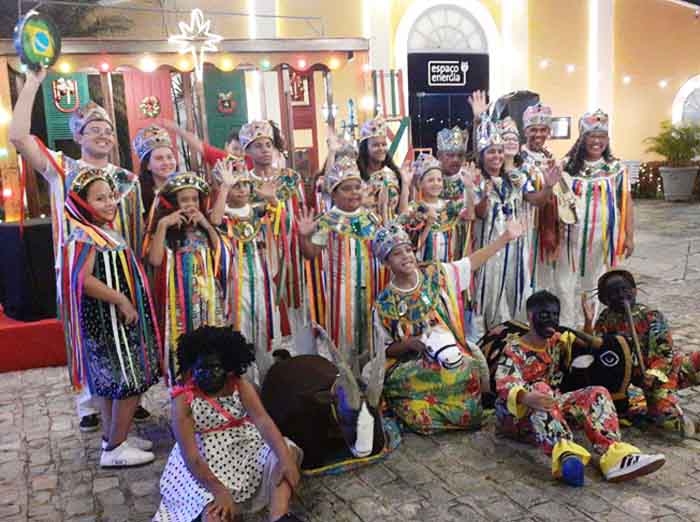New donations for theater groups
The Barba Varley Foundation adopts:
The Cavalo marinho children's ensemble from João Pessoa, Brazil
Jocilene Cunha da Silva is 43 years old, lives in the city of João Pessoa-PB. Better known as Maestra Tina, she began her cultural activity with Dona Maria Nazaré (her grandmother) with the “de roda” songs. In 1996 he began practicing capoeira with Maestro Naldinho of the capoeira group Angola Community. Teacher Tina coordinates popular culture rehearsals and shows for the community of Bairro dos Novaes, in the city of João Pessoa-PB, Brazil.

Julia Varley tells the story of the meeting between “Mestra” Tina and Fondazione Barba Varley that has chosen to adopt this artistic form. Interview by Patrizia Pertuso (metronews.it )
Julia Varley, how did the meeting with “Mestra” Tina come about?
Last year Eugenio and I went to visit with Juliana Pardo and Alicio Amaral of the Mundo Rodà group, the two masters of the ISTA who teach Cavalo Marinho in Paraíba and who have been researching local folk dances for 25 years in that region. One afternoon they took us to see the rehearsal that “Mestra” Tina did in a popular neighbourhood of João Pessoa with children between 4 and 14 years old. Cavalo Marinho includes, in addition to choreographic dances, performances, masks, improvisations, songs and music in which the characters are involved, some humans like Mateu, and other animals including Boi, the ox.

It was very impressive to see these eight- or nine-year old children interpreting them because they did it with a conviction that is rare even in professional actors.
At the same time, you could clearly see the self-confidence that acting out these scenes gave them while having fun: on these occasions, in fact, they allow themselves to do things that, in normal life, they would not do.
Where did these rehearsals take place?
In the courtyard of a house where an elderly woman who we learned later was the owner of the house appeared at the door. On one side of the courtyard there were four musicians, adults who participated for free. For the children, at the end of the rehearsal, there were cakes, food and something to drink. “Mestra” Tina explained to us that a German NGO helped her pay the rent, which at the time only concerned the courtyard and therefore was not very high, and to buy some food for the children.
Who are the children who attend the school and participate in Cavalo Marinho?
They are children born in this popular neighbourhood, and many of them participate precisely because at the end they receive something to eat. They are not street children: they all have a place to live and someone who takes care of them, even though family relationships in these environments are very different from how we conceive them, with a mother, a father and children. There, the aunt, the cousin, the neighbour are all part of a family. The children go from one house to another and maybe live with four uncles. It is an extended family that involves the whole neighbourhood.
A neighborhood that, I imagine, participates in Cavalo Marinho.
Exactly. This year, when we returned to João Pessoa, we saw the performance of “Mestra” Tina with the children and with the inhabitants of the neighbourhood. They are all together: there are all skin colours, men, women, trans, homosexuals and among them there is a close relationship for which no one is privileged compared to others. In this year’s performance we found almost all the children who had participated last year together with others, new ones. Among the participants there was also a man who, in other places, would be defined as “the village simpleton”. It was very beautiful to see him dance with the children and observe their interrelations: they learn to share, to take care of costumes, to help “Mestra” Tina. This continuous participation over time underlines how this type of art is rooted in the neighbourhood.
Was it easy for you and Barba to get in touch with this reality?
Being introduced by Juliana Pardo and Alicio Amaral who have had a relationship with these people for many years was fundamental. We didn’t arrive as tourists, they immediately saw us as professionals who were interested in their popular art form. A familiarity was immediately established that, otherwise, would not have been possible.
Why did Fondazione Barba Varley decide to adopt this art form?
Tina told us that the owner of the house moved elsewhere and the current owners had dramatically increased the rent reaching a very high figure. So we promised to help her.
Have there been other adoptions in the past?
We supported the Balinese gambuh which is the oldest form of theatre together with the Japanese Noh. But this is the first adoption.
An important adoption considering that the Cavalo Marinho has become an Intangible Heritage of Paraíba.
The thing that struck us most is the transmission of this popular art form: it is experienced as a legacy received from a master that must be passed on, an important responsibility that attracts young people from all over the region. When we returned to João Pessoa this year we saw that there is continuity and a perspective that convinced us to support them.
How does this transmission of knowledge happen? Will the children who have learned this art then teach it to other children?
Among this year’s participants we saw a 14-year-old girl who is the one who will “inherit” the teaching of this popular art form. Using a whistle, she occasionally intervened in the performance and put the children in line. It is very important that these artistic traditions are not lost over time. And it is equally important for us to have activated this adoption so that “Mestra” Tina and those children can keep Cavalo Marinho alive.
Patrizia Pertuso

